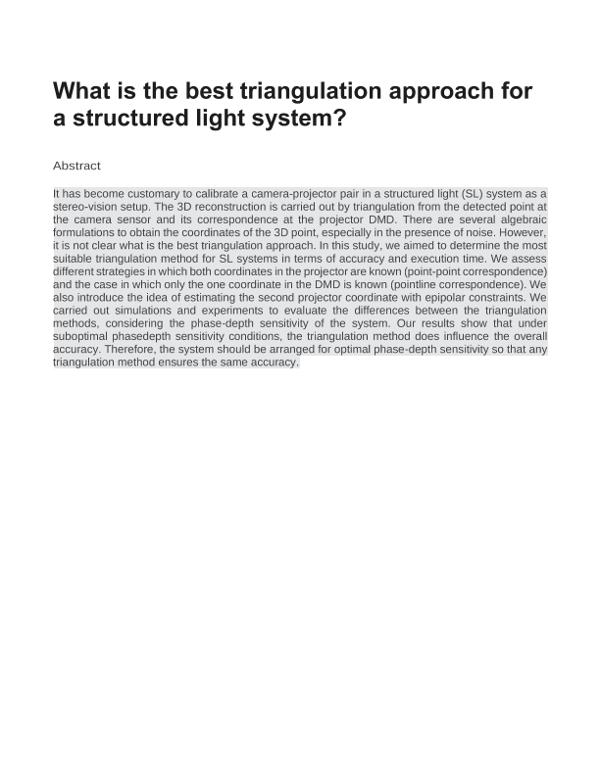Mostrar el registro sencillo del ítem
What is the best triangulation approach for a structured light system?
| dc.contributor.author | Meza, Jhacson | |
| dc.contributor.author | Vargas, Raúl | |
| dc.contributor.author | Romero, Lenny A. | |
| dc.contributor.author | Zhang, Song | |
| dc.contributor.author | Marrugo Hernández, Andrés Guillermo | |
| dc.date.accessioned | 2020-11-04T21:08:17Z | |
| dc.date.available | 2020-11-04T21:08:17Z | |
| dc.date.issued | 2020-05-18 | |
| dc.date.submitted | 2020-11-03 | |
| dc.identifier.citation | Jhacson Meza, Raul Vargas, Lenny A. Romero, Song Zhang, and Andres G. Marrugo "What is the best triangulation approach for a structured light system?", Proc. SPIE 11397, Dimensional Optical Metrology and Inspection for Practical Applications IX, 113970D (18 May 2020); https://doi.org/10.1117/12.2559119 | spa |
| dc.identifier.uri | https://hdl.handle.net/20.500.12585/9538 | |
| dc.description.abstract | It has become customary to calibrate a camera-projector pair in a structured light (SL) system as a stereo-vision setup. The 3D reconstruction is carried out by triangulation from the detected point at the camera sensor and its correspondence at the projector DMD. There are several algebraic formulations to obtain the coordinates of the 3D point, especially in the presence of noise. However, it is not clear what is the best triangulation approach. In this study, we aimed to determine the most suitable triangulation method for SL systems in terms of accuracy and execution time. We assess different strategies in which both coordinates in the projector are known (point-point correspondence) and the case in which only the one coordinate in the DMD is known (pointline correspondence). We also introduce the idea of estimating the second projector coordinate with epipolar constraints. We carried out simulations and experiments to evaluate the differences between the triangulation methods, considering the phase-depth sensitivity of the system. Our results show that under suboptimal phasedepth sensitivity conditions, the triangulation method does influence the overall accuracy. Therefore, the system should be arranged for optimal phase-depth sensitivity so that any triangulation method ensures the same accuracy. | spa |
| dc.format.mimetype | application/pdf | spa |
| dc.language.iso | eng | spa |
| dc.source | Proceedings Volume 11397, Dimensional Optical Metrology and Inspection for Practical Applications IX; 113970D (2020) | spa |
| dc.title | What is the best triangulation approach for a structured light system? | spa |
| datacite.rights | http://purl.org/coar/access_right/c_14cb | spa |
| oaire.version | http://purl.org/coar/version/c_970fb48d4fbd8a85 | spa |
| dc.type.driver | info:eu-repo/semantics/lecture | spa |
| dc.type.hasversion | info:eu-repo/semantics/publishedVersion | spa |
| dc.identifier.doi | 10.1117/12.2559119 | |
| dc.subject.keywords | Metrología óptica | spa |
| dc.subject.keywords | Optical Metrology | spa |
| dc.subject.keywords | Reconstrucción 3D | spa |
| dc.subject.keywords | Enfoque de triangulación | spa |
| dc.subject.keywords | 3D reconstruction | spa |
| dc.subject.keywords | Triangulation approach | spa |
| dc.rights.accessrights | info:eu-repo/semantics/closedAccess | spa |
| dc.identifier.instname | Universidad Tecnológica de Bolívar | spa |
| dc.identifier.reponame | Repositorio Universidad Tecnológica de Bolívar | spa |
| dc.publisher.place | Cartagena de Indias | spa |
| dc.type.spa | http://purl.org/coar/resource_type/c_c94f | spa |
| dc.audience | Investigadores | spa |
| oaire.resourcetype | http://purl.org/coar/resource_type/c_c94f | spa |
Ficheros en el ítem
Este ítem aparece en la(s) siguiente(s) colección(ones)
-
Productos de investigación [1453]
Universidad Tecnológica de Bolívar - 2017 Institución de Educación Superior sujeta a inspección y vigilancia por el Ministerio de Educación Nacional. Resolución No 961 del 26 de octubre de 1970 a través de la cual la Gobernación de Bolívar otorga la Personería Jurídica a la Universidad Tecnológica de Bolívar.












